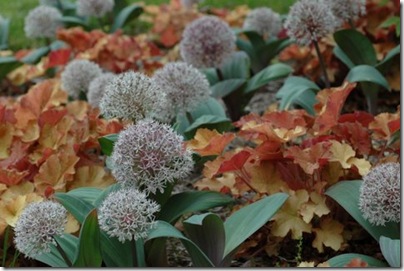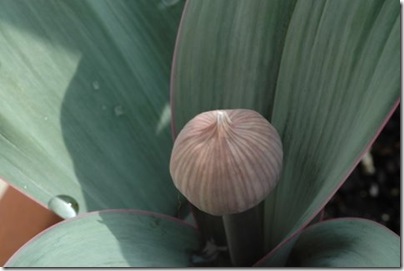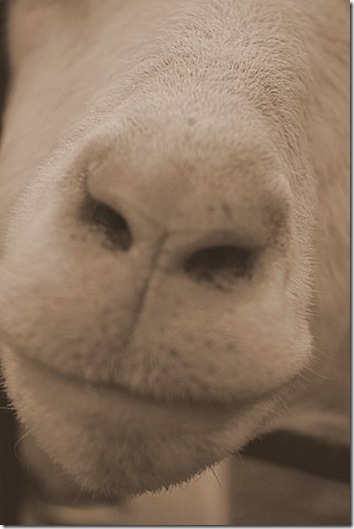Written by Tovah Martin
We are thrilled to have Tovah Martin contributing to Gardening Gone Wild. She is a freelance writer, lecturer, and author of over a dozen garden books including the recently published The New Terrarium. Tovah says that she has a problem with bulbs. It’s called obsession. The fires of infatuation were fanned when she chronicled Piet Oudolf and Jacqueline van der Kloet’s New York Botanical Garden installation for Seasonal Walk at NYBG. And multiple trips to Holland only made her heart race faster into the bulbosphere. Read more about what Tovah’s up to on her website. Fran Sorin
 Shoulders hunched, hood up, muffler enwrapped, I saw the flashlight coming up behind me. So I fell into step with my neighbor on our evening walk. Briefly, we exchanged pleasantries. Then she got immediately to the grit. “So,” she wanted to know, “you’ve been digging…” and she let it dangle. I knew what she was hinting at. I knew what was on her mind. “2,250 bulbs,” is all I answered. “Wait and see.”
Shoulders hunched, hood up, muffler enwrapped, I saw the flashlight coming up behind me. So I fell into step with my neighbor on our evening walk. Briefly, we exchanged pleasantries. Then she got immediately to the grit. “So,” she wanted to know, “you’ve been digging…” and she let it dangle. I knew what she was hinting at. I knew what was on her mind. “2,250 bulbs,” is all I answered. “Wait and see.”
I’d already fielded inquiries at the dump. You know the dump – the social hub of any thriving town. “Been messin’ around with that front lawn at your place again…?” and “Don’t you think enough is enough?” or “Lotta’ hard work…” Back at my place, a car slowed to a stop the other afternoon, rolled down its window, and a head popped out to yell, “I got a bulldozer you can borrow…” He didn’t finish the thought. And frankly, I didn’t want to break my momentum. (1,023…1,024…1,025…) A dog-walking couple saw a flashlight angled to illuminate a crouching figure near the road at dusk. “Just came over to make sure you were okay. Are you really…planting by moonlight?” They threatened to call the paper (I write for the paper), but they were just joking. The truth is, I know what’s going on underneath it all. They’re just feigning concern, they’re just playing the fool. More bulbs are what they’ve been hoping for all along. Secretly, they’re all rubbing their hands together in anticipation of spring. Deep down inside, they can’t wait.
Okay, here’s the story. No one ever complimented me on my crabgrass. My front lawn was no better or worse than anyone else’s in town. In fact, from 35 mph, it’s a vast improvement over the fertilized/herbicided versions during a drought. But it was equally boring. It sits across the driveway from my perennial border, but most of the joggers/dog walkers take the perennial border in their stride – it’s been around for 15 years. The other side of the driveway was just a large expanse of yawn (spelling correct on that). I put in a magnolia, a hydrangea, and a viburnum. But still, it was a big shrug.
Meanwhile, I’d been hanging around Piet Oudolf and Jacqueline van der Kloet’s plantings too long, I guess, because I yearned for something similar. Not only did the volume and loose lushness appeal, but the overall concept of merging expanses of seemingly natural plantings was seductive. Still, my only encounter was in public spaces.
I think the neighborhood assumed that I was going right back to the island bed fad of the 1980s at first, because I started small with a little blob of Heuchera villosa ‘Caramel’ (the only heuchera that doesn’t melt in bright sun – but this summer was the harrowing exception. Disappeared entirely. Anyone want to weigh in on whether I’ll see ‘Caramel’ alive again next spring?). The year before, the heucheras were constantly drenched. So they never really filled in. That’s when I called in the bulbs. It was sort of a last ditch solution to save the scene by burying some Allium karataviense among them. I sort of blindly inserted them irregularly (I call Jacqueline van der Kloet’s method “confetti”). Suddenly, in spring, the planting popped. Did you ever notice that dog walkers tend to look at the ground? Well, they were steering the Boston terriers up the driveway. “Tell me the name of the round things,” they’d beg, handing me a biscuit to placate the pooches. If the dogs behaved themselves, I spelled out karataviense.
 Allium karataviense afforded several months of wonder to win me fame well into Independence Day. First week in June, it was fiery orange heuchera foliage beside jewel-like pink orbs above blue accordion-pleated foliage. The flowers took their time before fading and the foliage lingered even longer. Meanwhile, I was expanding. Digging up more real estate and later on, adding bulbs. Mostly in the allium and fritillaria department, because the passing puppies have done nothing to diminish my vole/chipmunk/squirrel issues.
Allium karataviense afforded several months of wonder to win me fame well into Independence Day. First week in June, it was fiery orange heuchera foliage beside jewel-like pink orbs above blue accordion-pleated foliage. The flowers took their time before fading and the foliage lingered even longer. Meanwhile, I was expanding. Digging up more real estate and later on, adding bulbs. Mostly in the allium and fritillaria department, because the passing puppies have done nothing to diminish my vole/chipmunk/squirrel issues.
I’ll catch you up to date on the expansion in a future blog. Stay tuned. In the meantime, I need some help. I want to move out of the margin of safety rodent wise and into other bulbs like crocus and that sort of thing. The crushed oyster shells that work wonders on tulips haven’t protected tastier little morsels. I got Brent on the phone (you know Brent Heath from Brent and Becky’s Bulbs) and he claims that Crocus tommasinianus is rodent proof. So far, the squirrels have robbed me blind of crocus except a few token bulbs by the front door. Brent also shared another trick. He uses Plantskydd. Nothing smells worse than Plantskydd, I’ve got to say. It’s dried blood, so you can just imagine. If you survive an application without losing your lunch, then you’ve got a more ironclad digestive system than mine. But for anyone who’s olfactorily challenged, it’s the way to go, according to Brent.
 Another friend, Mary Stambaugh shared her solution and this one is much more user-friendly for all the vegetarians out there (hey I’m with you). “Just place some flat stones on top of your planting until spring,” she suggested. I’m from Connecticut, and we rock. So there’s definitely a readily available surplus of stones free for the schlepping. As soon as I can stand upright again, I’m going to give it a go. Unless you have a better idea…
Another friend, Mary Stambaugh shared her solution and this one is much more user-friendly for all the vegetarians out there (hey I’m with you). “Just place some flat stones on top of your planting until spring,” she suggested. I’m from Connecticut, and we rock. So there’s definitely a readily available surplus of stones free for the schlepping. As soon as I can stand upright again, I’m going to give it a go. Unless you have a better idea…
